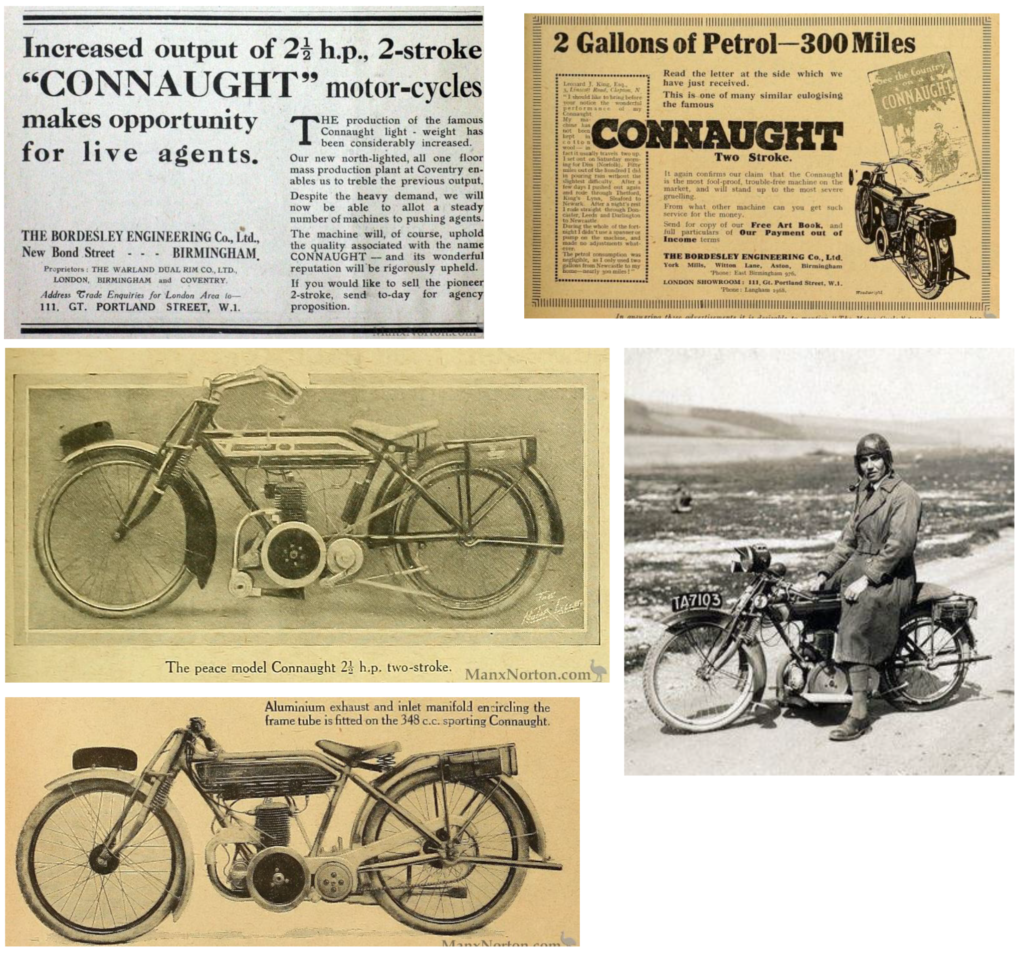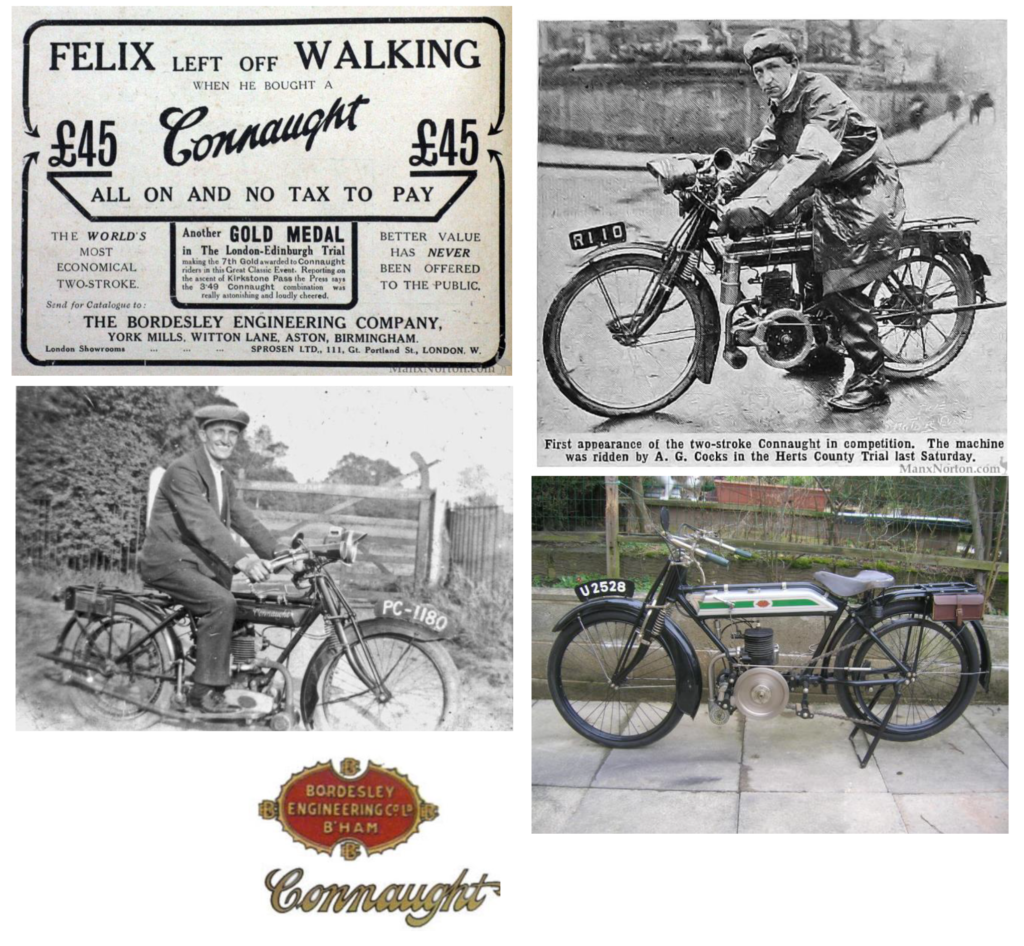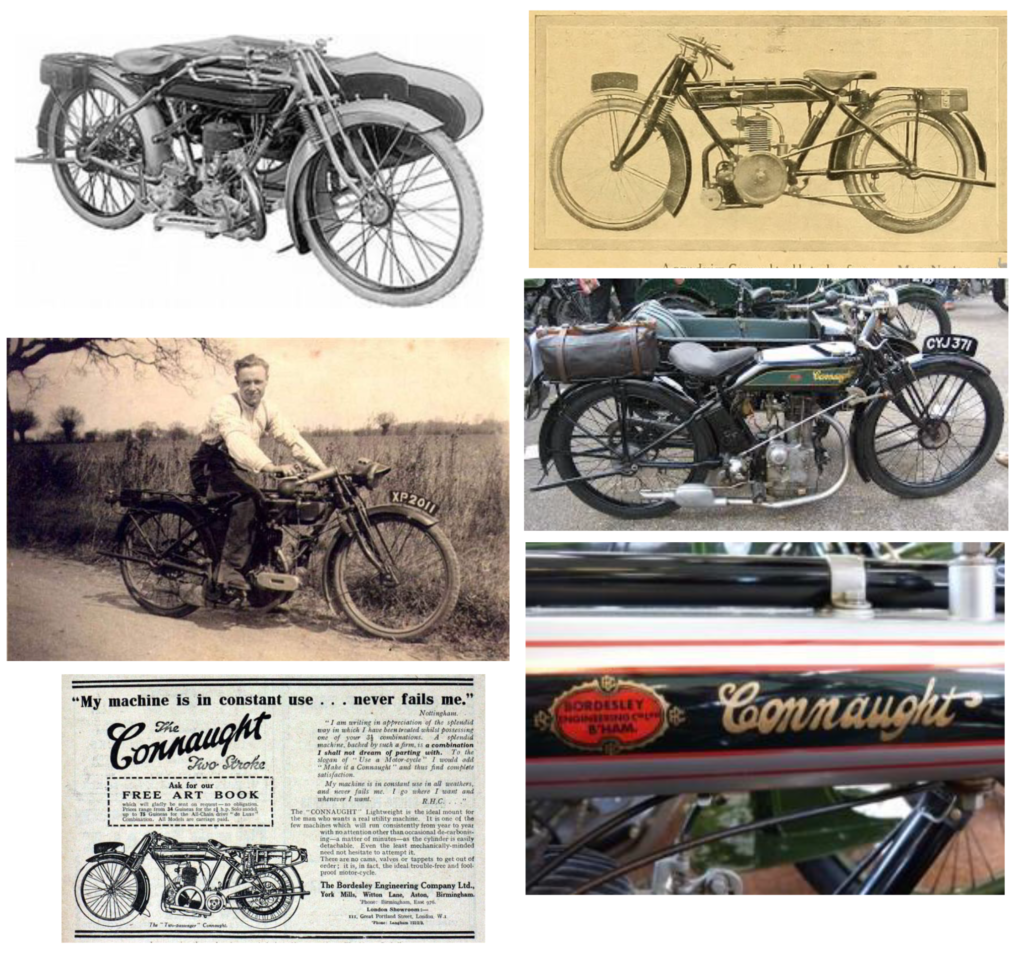HISTORY
Manufactured by Bordesley Engineering Co. of New Bond Street, Birmingham. The company was formed in 1910 . Engines were assembled at New Bond Street and cycles assembled at York Mill. They built Connaught motorcycles from 1912 to 1926
In 1912 The first machine was exhibited at the Olympia Show. They had one basic model, with a 293cc petroil-lubricated two-stroke engine and Amac carburettor at the rear of the cylinder. The engine design was quite advanced and inside it had a one-piece crankshaft, a connecting rod with split big-end and a deflector piston. It also had belt drive, single speed and sprung forks.
In 1914 various transmissions were available to offer, one, two or three speeds and belt or chain-cum-belt drive. There was also a ladies’ version and all had the same engine. An oil receptacle, held by bayonet joint to a tap on the oil tank, enabled the rider to draw off a measured amount to mix with the petrol.
Connaught 1914
1915-1916 The range continued for those two years and then production ceased for the remainder of the Great War.
1919 Following the armistice models were produced with single or two-speed variants plus a Miniature which had smaller, 24-inch wheels. For the next few years there was little change.
Connaught 1919
1922 The Miniature was dropped and a 348cc two-stroke model appeared. This had a three-speed Burman gearbox and all-chain drive.
1923 Various machines of various specifications continued to be produced, including a complete sidecar outfit with a larger engine.
Connaught 1923
1924 The marque was bought by the J. E. S. Motor Company and production moved to Gloucestershire for a while, before going back to Birmingham.
Connaught 1924
1925 Change of ownership brought a change in design and they added four-strokes with a Blackburne ohv, an oil-cooled Bradshaw and an sv engine of their own make. Yet more four-strokes were added, with either Blackburne or Bradshaw engines.
1926 They now listed two models fitted with their own engine as well as several other models with Blackburne, Bradshaw JAP units. They also built a solitary two-stroke. It was their last year of production.
The Warland-Blackburne was a motorcycle produced in 1923, by the Bordesley Engineering Company, of New Bond street, Birmingham. This was a reasonably priced machine fitted with a 348cc sv Blackburne engine with three-speeds and all-chain drive, Druid side-spring forks, BTH magneto and an Amac carburettor. As these were all industry
Connaught were one of the two pioneer manufacturers of simple two-strokes which popularised this type of machine.
After four years of war, one naturally expects alterations
from a firm manufacturing its own engine, but although the Bordesley Engineering Co. has been practically exclusively engaged upon “munitions” during the war, the principals have found time to experiment. The results of these experiments have not brought forth any discoveries necessitating alterations to the engine, consequently the peace model Connaught follows the pre-war models closely, with the addition of minor refinements.
The engine has a bore and stroke of 73 mm. and 70 mm. respectively, the capacity being 293 c.c. and, as in the pre-war model, the cylinder is offset, which, it is claimed, permits of a more effective scavenging by reason of the slow movement of the piston at the points of exhaust and intake. The exhaust and inlet ports are superimposed, so that the mixture passes into a chamber in the manifold, which is separated from the exhaust chamber by a thin partition of steel. By this means the cold gas takes up some of the heat of the exhaust, cooling the later, and becoming more thoroughly vaporised. This feature is patented, and is used in one or two other leading makes under licence from the Connaught firm.
It may be remembered that it was the Bordesley Engineering Co. which introduced the petroil system of lubrication into this country, and, while it was much ridiculed at the time of its introduction, it has been found fully efficient for two-stroke engines, not only by the Connaught concern, but also by many others. The war-time experiments of the makers of this lightweight have been with lubrication, and it is interesting to note that they still retain the system, and have every confidence that it is the best method of introducing lubricant into the engine.
One of the new features of the machine is the tank, which is most pleasing to the eye. The edges have broad bevels, and with the aluminium and red panels give the machine a very distinctive appearance.
The machine is fitted with 26x.2in. tyres, and weighs 125 lb., with single gear, all-belt drive, the price being £42. With a countershaft two-speed gear and clutch, the price is £53, and without clutch £49 15s.
A miniature model with 24x2in. tyres is also catalogued, a single gear machine at £34 and a two-speed at £42 15s.
In 1926 the company ceased trading.



